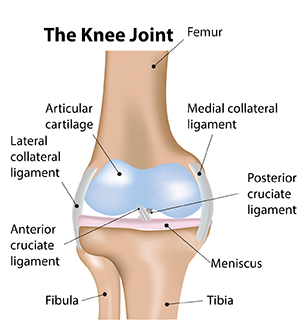Alleviating Knee Pain
Posted on October 4, 2015 by bob in Health
“As cartilage thins, your bones begin to rub together,
causing pain, swelling and stiffness.”
The most common cause of knee pain can hit you at any age — your 30s or 40s as easily as your 60s and 70s. Orthopaedic surgeon Robert Nickodem, Jr., MD, says osteoarthritis, or “wear-and-tear arthritis,” is the most common cause of knee pain. It includes more than 100 types of arthritis or joint inflammation.
“Osteoarthritis is like a rusty hinge,” says Dr. Nickodem. “The knee still works, but it creaks.” To help alleviate the “creaking” and soothe the discomfort, Dr. Nickodem recommends:
— Anti-inflammatory medications; aspirin or ibuprofen. Acetaminophen, a pain reliever, does not reduce inflammation.
— RICE therapy. Rest, Ice, Compression and Elevation can help reduce swelling and pain.
— Physical therapy. Exercise that strengthens your quads and hamstrings may help relieve pressure on your knees.
— Knee braces. They can take pressure off the arthritic area.
— Cortisone injections. An occasional injection of this steroid may lessen the swelling and achy pain.
— Lubricant injections. Viscosupplementation, or lubricant injections can help the knee move more smoothly. “It can help three out of four people if the arthritis isn’t too severe,” Dr. Nickodem says.
‘Wear and tear’ arthritis
How can you tell if you have osteoarthritis?
“If you have pain inside your knee, under your kneecap, especially when kneeling, squatting or going up and down steps, it’s usually wear-and-tear arthritis,” says Dr. Nickodem.
Cartilage, the cushioning between bones, deteriorates throughout life. It can erode more quickly in some people due to injury or genetics. As cartilage thins, your bones begin to rub together, causing pain, swelling and stiffness.
When to call your doctor
If your pain and swelling are getting worse and you can no longer put weight on your knee, see your doctor. A simple X-ray can show if there is osteoarthritis and, if needed, an MRI scan can check for meniscal tears or loose chips of cartilage.
Arthroscopic surgery can sometimes remove loose cartilage. Partial or total knee replacements are other surgical options, especially for those who can no longer stay as active as they’d like.
“Surgery is a last resort, though,” says Dr. Nickodem. “It’s something to consider when nonoperative treatments aren’t helping.”
Courtesy: Health Hub, Cleveland Clinic, http://health.clevelandclinic.org/2014/08/what-you-can-do-about-stiff-achy-knees/.









